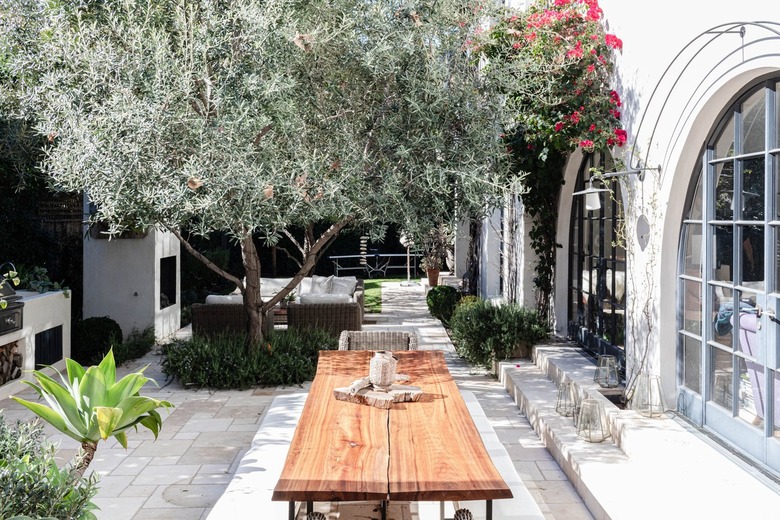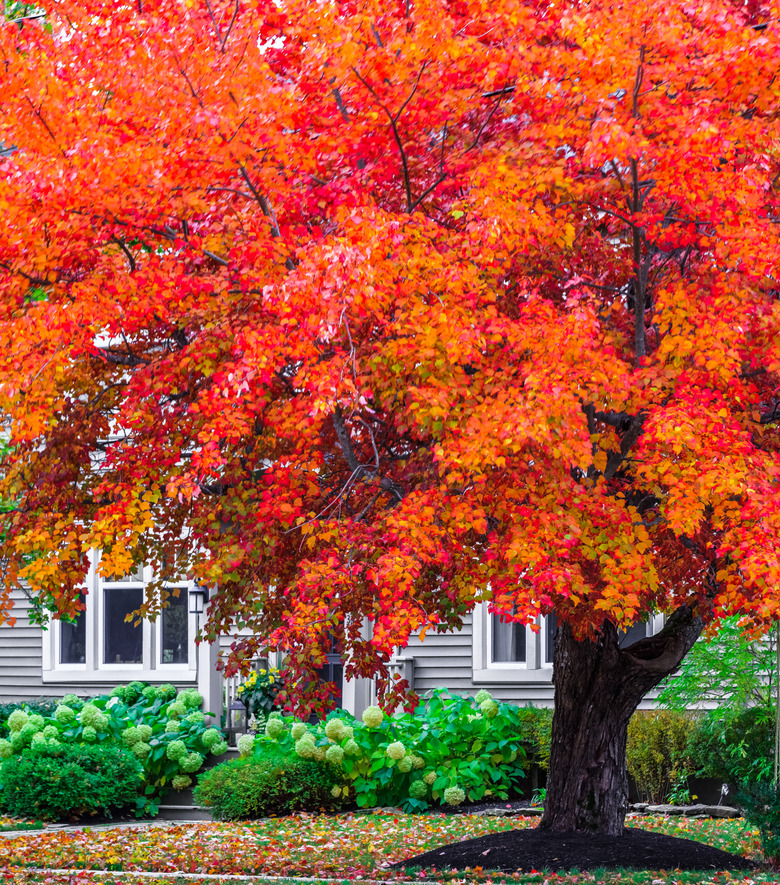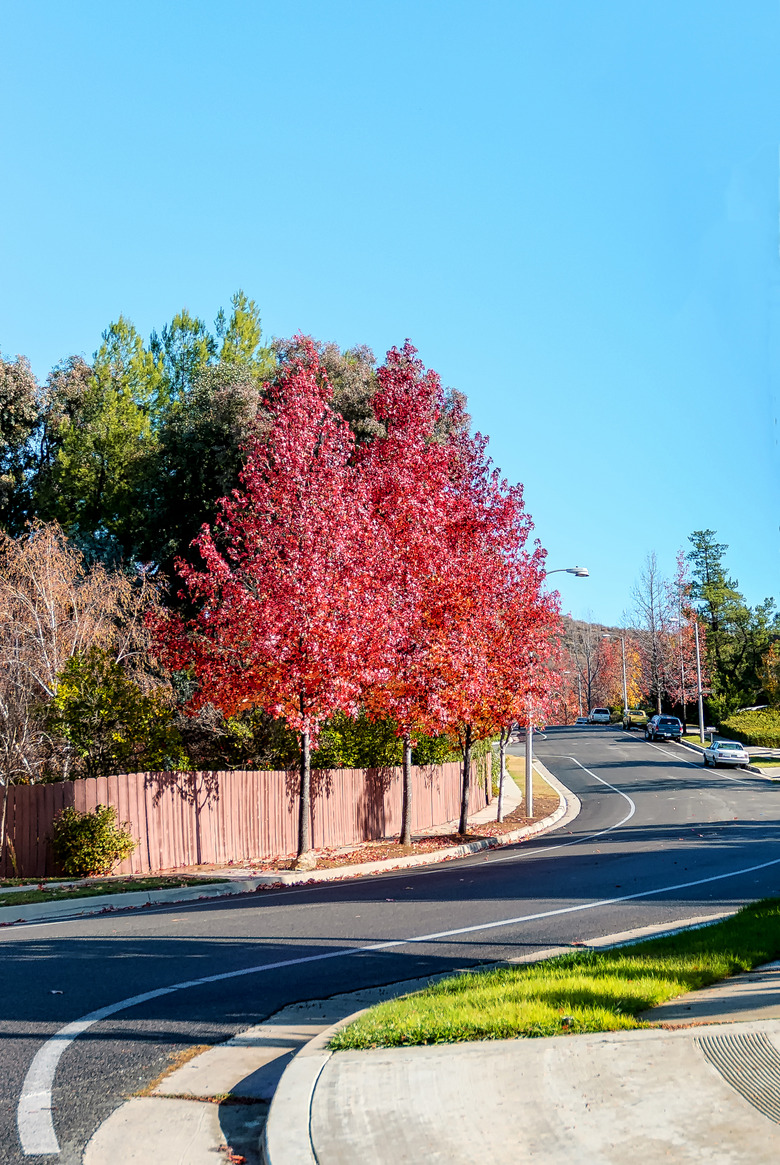10 Best Fast-Growing Shade Trees
We may receive a commission on purchases made from links.
Fast-growing shade trees can transform a landscape in just a few years, adding aesthetic as well as functional benefits. Shade trees add beauty to the landscape, offer relief from summer heat and can even lower your yearly air-conditioning bills up to 56 percent, according to the USDA Forest Service. By choosing a deciduous shade tree — one that loses its leaves in autumn — you may be treated to a glorious riot of fall foliage color. If you choose an evergreen shade tree, the year-round privacy it offers may be well worth the trade-off of not having colorful leaves in autumn.
As a heads up, be sure to do your homework before purchasing any tree marketed as a "fast-growing shade tree." The "fast-growing" and "shade" parts of the description certainly fit the bill as desirable qualities. However, many trees with a rapid growth rate carry a long-term cost that's not reflected in the initial price you pay. The downside is that many of these fast growers have structural problems that may leave your landscape littered with downed limbs or even fallen trees that can wipe out the shade that you originally wanted.
Undesirable Fast-Growing Shade Trees
Undesirable Fast-Growing Shade Trees
Although by no means the only examples of fast-growing trees that you may want to avoid planting, these three examples of ill-advised tree species populate the lists of many reputable sources, including Oklahoma State University Extension. Look for these telltale signs of undesirable traits to avoid when you're shopping for fast-growing shade trees:
- Silver maple (Acer saccharinum). Across its
perennial range in U.S. Department of Agriculture (USDA) plant hardiness zones 3
through 9, silver maple has many desirable qualities. It's a beautifully
shaped, fast-growing native tree with leaves that have silvery undersides, and
it tolerates wet soils. However, as the Missouri Botanical Garden notes, its
weak and brittle branches are prone to splitting, especially during periods of
strong winds or icy/snowy weather. - Callery pear (Pyrus calleryana). Perhaps the
best-known callery pear cultivar is Bradford pear (Pyrus calleryana 'Bradford,'
USDA zones 5 through 9). As a spring-blooming tree, callery pear illuminates a
landscape with its brilliant white flowers. Although originally bred as a
sterile tree, the Missouri Botanical Garden reports that callery pear has nonetheless proved to produce viable seed when
cross-pollinated with another callery pear cultivar, which has led to its invasive
tendency to naturalize some areas. In addition to its invasive nature, callery pear's
multiple trunks are prone to splitting, disfiguring trees or even tearing them in half. On top of all that, they have an undesirable smell—often compared to fish or cat food scents. - Poplar (Populus spp.). Commonly called Eastern
cottonwood (Populus deltoides, USDA zones 3 through 9), this tree is actually a
poplar species. Along with other poplar species, Eastern cottonwood is a fast
grower that the California Polytechnic State University Urban Forest Ecosystems Institute (UFEI) reports as having a growth rate of 36 inches per year. The institute also rates its branch strength as weak, and the Missouri Botanical Garden categorizes this species as well as other poplar species as poor selections for urban
landscapes.
1. Northern Red Oak
1. Northern Red Oak
Stately oaks (Quercus spp.), a go-to tree species for shade benefits, are often slow-growing, but Northern red oak (Quercus rubra, USDA zones 5 through 9), often simply called "red oak," is a fast-growing oak tree. Cal Poly UFEI notes that Northern red oak may put on 36 inches of new growth each year. Pin oak (Quercus palustris, USDA zones 5 through 8) also grows at this same rate, but its thin leaves hang onto the tree throughout fall after they turn brown and then fall in sporadic bursts, which keeps a landscape looking unkempt over a long period of time.
Northern red oak grows to a mature height of 60 to 80 feet with a 50- to 70-foot spread, and healthy trees live more than 150 years. With brilliant fall color from leaves in shades of red and purple, Northern red oak's branches have a strong rating. Full sun to partial shade and moist soil provide optimal growing conditions.
2. October Glory Red Maple
2. October Glory Red Maple
The October Glory red maple tree (Acer rubrum 'October Glory,' USDA zones 4 through 9) is a female cultivar that sports brilliant reddish-orange leaves in autumn. You don't have to wait until fall arrives to see the color red on these trees. The "red" in red maple's common name certainly describes this tree's fall leaf color, but red maples also have red petioles (leaf stems) during the growing season when the leaves are green.
Cal Poly UFEI reports a growth rate for October Glory of more than 24 inches per year until the tree reaches a mature height of 40 to 50 feet with a spread of 25 to 35 feet. One cultural condition that you'll want to consider when planting October Glory is its affinity for wet soil that drains well. So, if you live in an arid climate with dry soil, you'll have to keep this tree well irrigated for it to prosper.
3. Autumn Blaze Freeman Maple
3. Autumn Blaze Freeman Maple
Although silver maple is on the list of fast-growing but weak-wooded shade trees, it's one of the parent plants of an improved hybrid maple. Autumn Blaze maple (Acer freemanii 'Jeffersred' AUTUMN BLAZE, USDA zones 3 through 8) is a Freeman maple cultivar. As the Missouri Botanical Garden notes, Freeman maple trees are the result of crossing red maple (Acer rubrum) and silver maple (Acer saccharinum), which produces a hybrid tree that has the fast-growing quality of silver maple plus the form, leaf color and branch strength of a red maple.
With a mature height of 40 to 55 feet and a 30- to 40-foot spread, Autumn Blaze maple has similar cultural requirements as October Glory maple, preferring moist to wet soil that drains well in a full-sun to partial-shade location. Even though this tree prefers moist soil, it is fairly drought tolerant once established. Fall leaf color is in shades of orange, scarlet and red.
4. Tulip Poplar Tree
4. Tulip Poplar Tree
Poplar (Populus spp.) is another tree on the undesirable list of fast-growing shade trees, but despite its common name, tulip poplar (Liriodendron tulipifera, USDA zones 5 through 9) is not a true poplar. Also called "tulip tree" because of the appearance of tulip-shaped flowers in spring as well as tulip-shaped leaves, you'll need to provide plenty of growing room for this plant.
With a growth rate of 36 inches each year, according to Cal Poly UFEI, mature trees in residential landscapes typically reach a height of 60 to 80 feet and a width of 40 feet. However, the University of Kentucky notes that a specimen in that state called the "Kentucky Champion tree" is 168 feet tall, which is fitting since the tulip poplar is the state tree of Kentucky.
Hummingbirds love tulip poplar flowers, but you may only see them when the wind flutters the wide leaves to reveal the blooms. Full sun or partial shade and moist, acidic soil are optimal for tulip poplar's health.
5. Golden Rain Tree
5. Golden Rain Tree
One of the fast-growing shade trees on Fafard's top 10 list is golden rain tree (Koelreuteria paniculata, USDA zones 5 through 8). Not only does golden rain tree have a beautifully rounded canopy to provide shade but it bursts into bloom in midsummer with a riot of yellow flowers that cover the branches with sprays of blossoms. Even before the summer flowers appear, golden rain tree is colorful. The new spring leaves emerge pinkish or purplish, and they turn yellow in autumn.
Unlike larger shade trees that are better suited to larger yards, golden rain tree is suitable for smaller landscapes with its mature height of 30 to 40 feet with an equal spread. The Missouri Botanical Garden designates this plant as a low-maintenance tree that has few cultural needs. It's tolerant of drought, is not fussy about the type of soil on which it grows and even tolerates air pollution.
6. Japanese Zelkova Tree
6. Japanese Zelkova Tree
Another fast-growing shade tree on Fafard's top 10 list is Japanese zelkova (Zelkova serrata, USDA zones 5 through 8). Although it's in the same plant family as elm trees (Ulmus spp.), Japanese zelkova is highly resistant to the Dutch elm disease that all but eradicated the American elm (Ulmus americana, USDA zones 2 through 9). In fact, the Missouri Botanical Garden notes that Japanese zelkova is recommended as a substitute tree for American elm.
With a growth rate up to 36 inches per year, Cal Poly UFEI reports that Japanese zelkova reaches a mature height of 50 to 80 feet with an equal spread. Its species name, serrata, hints at one of its other features — serrated leaf margins — that also gives this tree another of its common names: sawleaf zelkova. Full sun, moderate water and tolerance to air pollution make Japanese zelkova a suitable choice for most urban conditions.
7. Chinese Pistache Tree
7. Chinese Pistache Tree
Southern Living ranks Chinese pistache (Pistacia chinensis, USDA zones 6 through 9) as one of its recommended fast-growing shade trees. Although it's an ornamental pistachio tree that doesn't bear pistachio nuts like its close plant relative, it's a real gem in the landscape as a fast-growing shade tree for smaller yards that has strong branches that are not susceptible to splitting or cracking. Chinese pistache typically grows to a mature height of 30 to 35 feet with a spread of 20 to 25 feet.
This is a lovely fast-growing tree to shade your patio or favorite garden bench. Fall leaf color may be orange to fiery red. As a forgiving tree that's drought tolerant when established, Chinese pistache handles moist or dry soil, full sun or partial shade and almost any type of soil with ease. Even though it needs good drainage, Cal Poly UFEI notes that it's resistant to oak root fungus.
8. Sweet Gum Tree
8. Sweet Gum Tree
If you've ever grown an American sweetgum tree (Liquidambar styraciflua, USDA zones 5 through 9), you may wince at its inclusion on a "best" list for fast-growing shade trees. It easily meets the criterion of "fast growing," as noted by Cal Poly UFEI, with a growth rate of up to 36 inches per year, and it also meets the criterion of providing shade because of its mature size (80 feet tall and 40 feet wide) and broad leaves. However, it also produces round, spiky fruits called "gum balls" that fall from winter through spring and litter the ground with potential ankle-turning hazards.
With that caveat aside, the Missouri Botanical Garden offers a simple solution. 'Rotundiloba' is a cultivar that does not produce fruit. Plant this tree and you'll have all the desirable landscape qualities of the species without all the mess. Full sun and moderate water are the basic needs of this low-maintenance tree.
9. Bald Cypress Tree
9. Bald Cypress Tree
A fast-growing shade tree that looks like an evergreen because of its foliage is bald cypress (Taxodium distichum, USDA zones 4 through 9). This tree is a deciduous conifer, which means that it has needle-like foliage and produces cones like evergreen trees, but it sheds this foliage in autumn like deciduous trees. Bald cypress is commonly known for growing in swampy regions, but as a testament to its versatility, it also grows in suburban settings.
Although it grows best in moist to wet soils, even prospering in standing water, bald cypress is also adapted to growing in moderately dry soils. To reach its mature height of 60 to 80 feet with a 25- to 35-foot spread, Cal Poly UFEI reports that bald cypress can put on 36 inches of growth per year. When bald cypress drops its copper-colored needles in fall, the needles help keep the soil around the tree moist by forming a mulch cover.
10. Green Giant Arborvitae
10. Green Giant Arborvitae
For unbeatable fast growth and evergreen appeal, it's hard to beat Green Giant Arborvitae (Thuja 'Green Giant,' USDA zones 5 through 8). Unlike so many needled evergreen trees that are prone to pests and diseases, Green Giant is remarkably pest- and disease-resistant. Under optimal growing conditions, the Missouri Botanical Garden notes that this tree can add new growth of up to 48 inches each year until it reaches its mature size of 40 to 60 feet tall and 12 to 18 feet wide.
Green Giant naturally grows into a pyramidal shape with dense foliage that offers privacy as well as shade. Its foliage stays lush and full during winter without turning yellow, and its cultural requirements are few: full sun to partial shade, moderate water and soil that drains well. Although it prefers evenly moist soil, Green Giant tolerates moderately dry conditions after it's established. If you're growing newly transplanted trees, keep the soil evenly moist to help promote the fastest growth.
References
- USDA Forest Service: Trees
- Oklahoma State University Extension: Selecting Deciduous Trees for Oklahoma
- Missouri Botanical Garden: Acer saccharinum
- Missouri Botanical Garden: Pyrus calleryana 'Bradford'
- California Polytechnic State University Urban Forest Ecosystems Institute: Eastern Cottonwood
- Missouri Botanical Garden: Populus deltoides
- California Polytechnic State University Urban Forest Ecosystems Institute: Red Oak
- California Polytechnic State University Urban Forest Ecosystems Institute: Pin Oak
- California Polytechnic State University Urban Forest Ecosystems Institute: October Glory Red Maple
- Missouri Botanical Garden: Acer x freemanii 'Jeffersred' AUTUMN BLAZE
- California Polytechnic State University Urban Forest Ecosystems Institute: Tulip Tree
- University of Kentucky: Tulip Poplar
- Fafard: Top 10 Tough Fast-Growing Shade Trees
- Missouri Botanical Garden: Koelreuteria paniculata
- Missouri Botanical Garden: Ulmus americana
- California Polytechnic State University Urban Forest Ecosystems Institute: Sawleaf Zelkova
- Missouri Botanical Garden: Zelkova serrata
- California Polytechnic State University Urban Forest Ecosystems Institute: Chinese Pistache
- California Polytechnic State University Urban Forest Ecosystems Institute: American Sweetgum
- Missouri Botanical Garden: Liquidambar styraciflua
- California Polytechnic State University Urban Forest Ecosystems Institute: Bald Cypress
- Missouri Botanical Garden: Thuja 'Green Giant'


